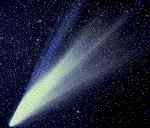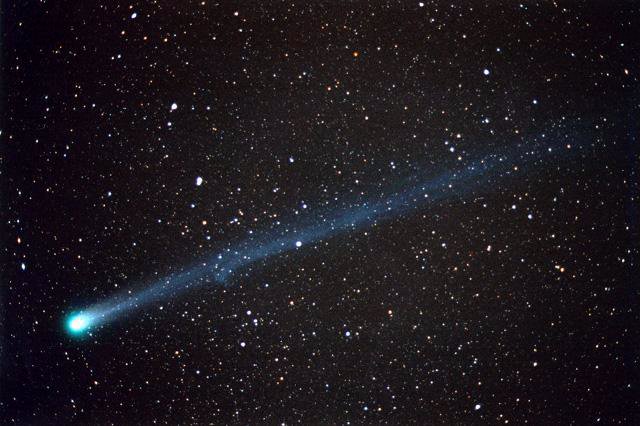Unlike the other small bodies in the solar system, comets have been known since antiquity. There are Chinese records of Comet Halley going back to at least 240 BC. The famous Bayeux Tapestry, which commemorates the Norman Conquest of England in 1066, depicts an apparition of Comet Halley.
Comet History
As of 1995, 878 comets have been cataloged and their orbits at least roughly calculated. Of these 184 are periodic comets (orbital periods less than 200 years); some of the remainder are no doubt periodic as well, but their orbits have not been determined with sufficient accuracy to tell for sure.
Comets are sometimes called dirty snowballs or "icy mudballs". They are a mixture of ices (both water and frozen gases) and dust that for some reason didn't get incorporated into planets when the solar system was formed. This makes them very interesting as samples of the early history of the solar system.
When they are near the Sun and active, comets have several distinct parts:
- nucleus: relatively solid and stable, mostly ice and gas with a small amount of dust and other solids;
- coma: dense cloud of water, carbon dioxide and other neutral gases sublimed from the nucleus;
- hydrogen cloud: huge (millions of km in diameter) but very sparse envelope of neutral hydrogen;
- dust tail: up to 10 million km long composed of smoke-sized dust particles driven off the nucleus by escaping gases; this is the most prominent part of a comet to the unaided eye;
- ion tail: as much as several hundred million km long composed of plasma and laced with rays and streamers caused by interactions with the solar wind.

Comets are invisible except when they are near the Sun. Most comets have highly eccentric orbits which take them far beyond the orbit of Pluto; these are seen once and then disappear for millennia. Only the short- and intermediate-period comets (like Comet Halley), stay within the orbit of Pluto for a significant fraction of their orbits.

After 500 or so passes near the Sun off most of a comet's ice and gas is lost leaving a rocky object very much like an asteroid in appearance. (Perhaps half of the near-Earth asteroids may be "dead" comets.) A comet whose orbit takes it near the Sun is also likely to either impact one of the planets or the Sun or to be ejected out of the solar system by a close encounter (esp. with Jupiter).
By far the most famous comet is Comet Halley but SL 9 was a "big hit" for a week in the summer of 1994.
Meteor shower sometimes occur when the Earth passes thru the orbit of a comet. Some occur with great regularity: the Perseid meteor shower occurs every year between August 9 and 13 when the Earth passes thru the orbit of Comet Swift-Tuttle. Comet Halley is the source of the Orionid shower in October.
Many comets are first discovered by amateur astronomers. Since comets are brightest when near the Sun, they are usually visible only at sunrise or sunset. Charts showing the positions in the sky of some comets can be created with a planetarium program.
Interesting Facts about Comet
- Comets come from the Kuiper belt and the Oort Cloud. These areas of space are way out in the solar system far away from the Sun. The Oort cloud is so far away we have never even seen it! The comets visible from Earth are most likely ones that came from the closer Kuiper belt which is near Pluto.
- There are millions of comets, and they are all orbiting the Sun. Most take less than two hundred years to do so, and others travel much slower, potentially taking millions of years to complete an orbit.
- Comets spend most of their years in the Kuiper belt and Oort cloud. Every now and again two comets can crash into one another. When this happened, they often change direction, and this can throw them out towards the inner solar system.
- When a comet approaches the inner planets, it is warmed by the Sun. When this happens, it begins to melt and throws out dust and gas. This creates a head and the tail. The tail is the part of the comet we see in the sky. The tail always points away from the Sun. This means that sometimes the tail is behind the comet and sometimes it in front. It all depends on whether the comet is travelling towards or away from the Sun.
- Travelling through a comet’s tail is not dangerous. Earth even passes through them. When this happens, we see a meteor shower!
- The word comet comes from the Greek word Kometes meaning long hair. This is because of how a comet’s tail can look like long flowing locks of hair.
- Like asteroids, comets are leftovers from the formation of the Solar System. We don’t know an awful lot about them at this point, but scientists believe they may hold clues to how the Solar System came to be.
- The most famous comet of all time is Halley’s Comet. Halley is a periodic comet and is visible from Earth every 76 years and has been for centuries. It made its last appearance in 1986. Other famous comets include the Hale-Bopp Comet, Donati’s comet and the Shoemaker-Levy 9 Comet.

More about comets


- more comet images
- images of Comet Borrelly from DS1
- the upcoming Rosetta mission (ESA)
- Gary Kronk's Comet page
- The Bright Comet Chronicles
- Comet Hale-Bopp (C/1995 O1)
- the Comet Hale-Bopp Home Page from JPL
- press information sheet from Harvard-Smithsonian Center for Astrophysics
- info and images from Hawaii
- SpaceViews Comet Hale-Bopp, info and lots of links
- Statement by Alan Hale on Heaven's Gate mass suicide
- Comet Hyakutake (C/1996 B2
- HST images
- from JPL (if slow, try this mirror site)
- from ESO
- press information sheet from CfA
- Fact sheet from NSSDC
- images from NSSDC
- recipe to Make a Comet Nucleus from LANL
- Chiron Information and Documentation
- Comet information from the International Comet Quarterly
- Comet Observation Home Page from JPL
- Comet Ephemerides (and orbital elements)
- Stardust Mission home page
- Dirty Ice Balls, Time Capsules, or Harbingers of Doom?
- A Cosmic Snowball, small comets hitting Earth? (maybe not)
- Ulysses and the tail of Hyakutake
Open Issues
- What happens to comets after they have lost their volatile materials?
- What mechanism(s) perturb comets from their origin in the Oort cloud into orbits that take them into the inner solar system?
- Was it a comet or something else that caused the Tunguska fireball over central Siberia in 1908?
- Was it a comet or an asteroid that caused the Chicxulub crater in the Yucatan (and probably caused the extinction of the dinosaurs)?
- The Stardust mission will return samples of a comet for study in earthly labs.
